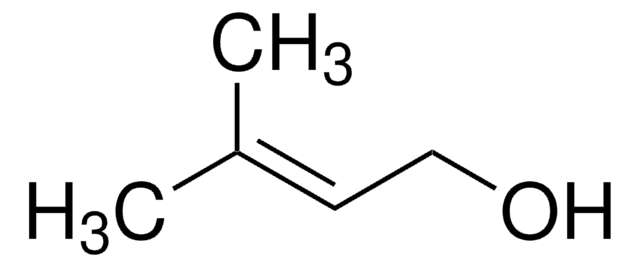M32658
3-Methyl-1-butanol
reagent grade, 98%
Sinonimo/i:
Isoamyl alcohol, Isopentyl alcohol
About This Item
Prodotti consigliati
Grado
reagent grade
Livello qualitativo
Densità del vapore
3 (vs air)
Tensione di vapore
2 mmHg ( 20 °C)
Saggio
98%
Stato
liquid
Temp. autoaccensione
644 °F
Limite di esplosione
1.2-9 %, 100 °F
Indice di rifrazione
n20/D 1.406 (lit.)
pH
5.6 (20 °C, 25 g/L)
P. ebollizione
130 °C (lit.)
Punto di fusione
−117 °C (lit.)
Densità
0.809 g/mL at 25 °C (lit.)
Stringa SMILE
CC(C)CCO
InChI
1S/C5H12O/c1-5(2)3-4-6/h5-6H,3-4H2,1-2H3
PHTQWCKDNZKARW-UHFFFAOYSA-N
Cerchi prodotti simili? Visita Guida al confronto tra prodotti
Categorie correlate
Applicazioni
Azioni biochim/fisiol
Avvertenze
Danger
Indicazioni di pericolo
Classi di pericolo
Acute Tox. 4 Inhalation - Eye Dam. 1 - Flam. Liq. 3 - Skin Irrit. 2 - STOT SE 3
Organi bersaglio
Respiratory system
Codice della classe di stoccaggio
3 - Flammable liquids
Classe di pericolosità dell'acqua (WGK)
WGK 1
Punto d’infiammabilità (°F)
110.3 °F - closed cup
Punto d’infiammabilità (°C)
43.5 °C - closed cup
Scegli una delle versioni più recenti:
Possiedi già questo prodotto?
I documenti relativi ai prodotti acquistati recentemente sono disponibili nell’Archivio dei documenti.
I clienti hanno visto anche
Il team dei nostri ricercatori vanta grande esperienza in tutte le aree della ricerca quali Life Science, scienza dei materiali, sintesi chimica, cromatografia, discipline analitiche, ecc..
Contatta l'Assistenza Tecnica.








